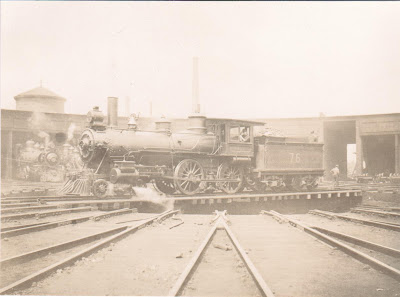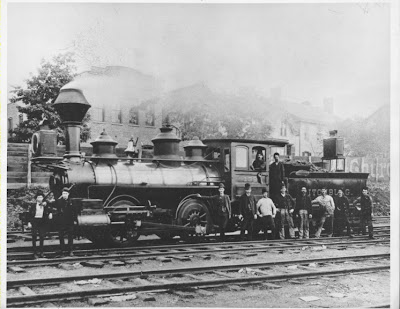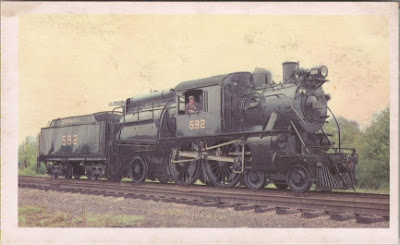 Built by Brooks Locomotive Company in 1918.
Built by Brooks Locomotive Company in 1918.
Wednesday, February 28, 2007
Tuesday, February 27, 2007
Boston & Maine Railroad Steam Locomotive #1094

Ex Fitchburg Railroad #139, 342 & 603.
Ex Troy & Boston 2nd "Pony" #13.
Built by the Schenectady Locomotive Works in 1879, builder #1122.
Monday, February 26, 2007
Boston & Maine Railroad Steam Locomotive #76
 Built by Manchester Locomotive Works in 1876, builder #714.
Built by Manchester Locomotive Works in 1876, builder #714.Later renumbered to 753.
Scrapped prior to 1914.
Sunday, February 25, 2007
South Buffalo Railway Locomotive #76
Saturday, February 24, 2007
Friday, February 23, 2007
Thursday, February 22, 2007
Delaware & Hudson Railroad Display Train


DELAWARE & HUDSON DISPLAY TRAIN
For three weeks during late April and early May 1973 the Delaware and Hudson dispatched a disply train, powered by the famous Alco PA locomotives, containing railroad history and contemporary displays commemorating their 150th anniversary, over the system from Montreal to Wilkes-Barre. The main attraction was the operating replica of the "Stourbridge Lion". People at Whitehall, N.Y. view the train on its stop there May 1st.
Photo by Carl H. Sturner
Wednesday, February 21, 2007
Tuesday, February 20, 2007
Norfolk & Western Steam Locomotive No. 117


NORFOLK & WESTERN NO. 117
In 1919, when the Norfolk & Western railroad found that it needed longer and heavier passenger trains, it ordered ten mighty 4-8-2, or Mountain, type engines to haul them at high speed in the mountain Districts. One 4.8-2 was No. 117 shown here with the Winston Salem local at the Roanoke, Virginia, station. All ten Mountains were equipped with streamlined shrouds as much for appearance as to combat wind resistance. Although Brooks Locomotive Works built all this lot— Nos. 116-125, the Norfolk & Western had its own locomotive-building shops, as did a few other railroads. These turned out modern coalburning iron horses until 1952. For several years after the American railroad industry as a whoIe had dieselized, the Norfolk & Western, located in one of the nations richest coal fields, was known as the last big stronghold of steam power in the United States. Eventually even the N. & W. followed the national trend by scrapping its "steamers"' in favor of diesels.
PHOTO BY O. WINSTON LINK
Monday, February 19, 2007
Boston & Maine Railroad #406 after collision on April 11, 1903


B&M 406 - Built by Manchester in 1887.
406 after being in collision on Shaw Ridge, April 11, 1903 2 AM.
Had orders to meet a job at Springvale they left their train on Shaws ridge and came down to Springvale to take water When Engr Reynolda saw the number of the train he was to meet pass her he thought it was a light engine and he pulled ??? and crashed into the head end.
Sunday, February 18, 2007
Saturday, February 17, 2007
Michigan Central Railroad Steam Locomotive #98

Originally "Pearl". Later #683.
Built by Manchester Locomotive Works in February, 1870, builder #224.
Scrapped in July, 1904.
Friday, February 16, 2007
Thursday, February 15, 2007
Fitchburg Railroad Steam Locomotive #139

Fitchburg R.R 139 formerly Troy & Boston R.R. 13.
Became Fitchburgh R.R in May 1887 renumbered 342 & 603.
Then became Boston & Maine 1097.
Scrapped in 1908.
Built by Schenectady in 1879. Builder # 1122.
CVL 16" x 22"
Thursday, February 08, 2007
Union Pacific Railroad Diesel Locomotive #61
Wednesday, February 07, 2007
Tuesday, February 06, 2007
Jersey Central Camelback

 This 41-2 (Atlantic) type engine, which Brooks Locomotive Co. built in 1901 for the Central Railroad of New Jersey, was one of several hundred "double-cabbers" that operated mostly in the East over a period of about seventy years, beginning in 1880. The middle cab resembled a camel’s hump or Mother Hubbard’s hood and was, therefore, called a Camelback or Mother Hubbard. In some Camelbacks the rear cab was so rudimentary that it was almost nonexistent. While this arrangement gave the engineer working on mid-boiler a better view of the track ahead, it lessened cooperation between him and his fireman shoveling coal in the tender behind. It was virtually impossible for the fireman to communicate with the engineer while the train was running, although the engineer could signal by bell or whistle; and in an emergency the fireman could stop the train by setting the air brake. Built for speed, Camelbacks pulled the fastest passenger trains on the Camden-Atlantic City run.
This 41-2 (Atlantic) type engine, which Brooks Locomotive Co. built in 1901 for the Central Railroad of New Jersey, was one of several hundred "double-cabbers" that operated mostly in the East over a period of about seventy years, beginning in 1880. The middle cab resembled a camel’s hump or Mother Hubbard’s hood and was, therefore, called a Camelback or Mother Hubbard. In some Camelbacks the rear cab was so rudimentary that it was almost nonexistent. While this arrangement gave the engineer working on mid-boiler a better view of the track ahead, it lessened cooperation between him and his fireman shoveling coal in the tender behind. It was virtually impossible for the fireman to communicate with the engineer while the train was running, although the engineer could signal by bell or whistle; and in an emergency the fireman could stop the train by setting the air brake. Built for speed, Camelbacks pulled the fastest passenger trains on the Camden-Atlantic City run.Monday, February 05, 2007
Montpelier and Wells River Railroad Steam Locomotive #9
Built by Manchester Locomotive Works in 1908. Builder #45125.
Subscribe to:
Posts (Atom)
Joseph A. Smith (1895-1978) was an avid collector of railroad photos, sharing many of them with fellow collectors in the Northeast. A former plumbing contractor, Smith presumably developed his interest in railroads through his father – a trolley motorman in Troy, NY.
His extensive collection focused on the lines that once served Troy: Delaware & Hudson, Rutland, Boston & Maine and New York Central. Many of his children – especially his sons Joseph Jr., James and Paul -- developed a similar interest and added to his collection with photos of their own. Maintaining the collection is now in the hands of his grandson, Kenneth Bradford. Coincidentally, Ken’s other grandfather worked as a manager at the Schenectady plant of the American Locomotive Company.
Smith was a life member of the Capital District Railroad Club of Schenectady. He was also a member of the Mohawk-Hudson Chapter Railway Historical Society and its parent organization, the National Railway Historical Society.
His extensive collection focused on the lines that once served Troy: Delaware & Hudson, Rutland, Boston & Maine and New York Central. Many of his children – especially his sons Joseph Jr., James and Paul -- developed a similar interest and added to his collection with photos of their own. Maintaining the collection is now in the hands of his grandson, Kenneth Bradford. Coincidentally, Ken’s other grandfather worked as a manager at the Schenectady plant of the American Locomotive Company.
Smith was a life member of the Capital District Railroad Club of Schenectady. He was also a member of the Mohawk-Hudson Chapter Railway Historical Society and its parent organization, the National Railway Historical Society.













